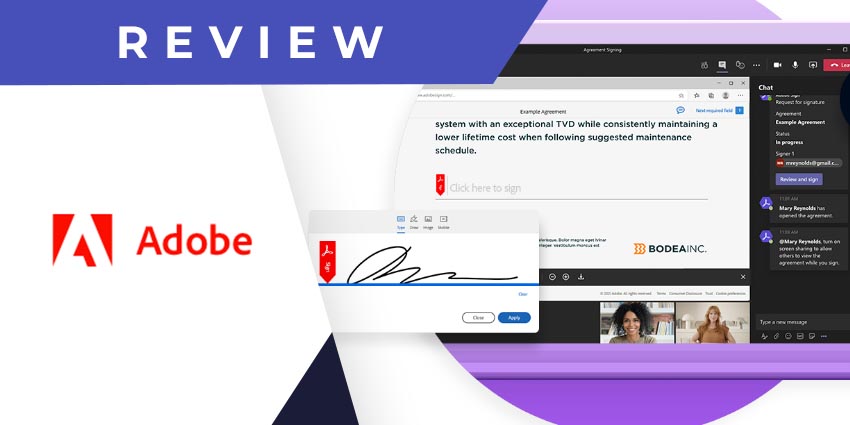Since 1982, Adobe has been among the world’s leading providers of enterprise technology and creative tools, with a robust cloud push in the last few years. Today, the company trades on its flagship perpetual license software platform and digital marketing and social marketing suite. One of the capabilities Adobe has picked up over the years is electronic signatures. In 2011, Adobe announced the acquisition of the web-based electronic signature company EchoSign, which would later form the foundation of the Adobe Sign service.
Adobe Sign integrates with collaboration and productivity apps like Workday, SAP Ariba, Salesforce, and Microsoft Teams to help sign documents as part of existing workflows. In 2021, Microsoft further strengthened the integration by linking Adobe Sign directly to the Microsoft Approvals service for use cases where required e-signatures sign off on work processes.
- DocuSign for Microsoft Teams Review: Simple, Bot-Based, and Potentially Your Default E-Signature Service
- PandaDoc for Microsoft Teams Review: Unlimited Free E-Signatures, No Compromise on Features
In addition to this, the Adobe Sign app for Teams has a host of compelling features. Let us review them in more detail.
Inside the Adobe Sign App
Adobe Sign has always had a sizable integration presence, with 40% of agreements on the service created through APIs. The Adobe Sign app for Teams brings this capability into the Teams ecosystem without requiring any further coding or development.
Once enterprises install Adobe Sign from the Teams marketplace, they can use it either as a bot in the chat interface or through the Adobe Sign tab which can be added to any channel. The bot helps to track signatures in a conversational interface, while the tab reveals advanced account capabilities like uploading new documents, managing existing agreements, monitoring agreement status, etc.
Here are the features that make it happen:
- Monitor agreement status: The Adobe Sign bot is the most effective way to check the status of a document, whether it has been signed, whether it is awaiting action, and if reminders need to be sent. The bot can process simple commands like “show docs for me,” “show docs for others,” and “check status,” automatically recommending users’ most recent documents for a status check. Users can also view the status of all their documents from the Manage Agreements option under the Adobe Sign tab on a channel, which will reveal all documents associated with their account that are in progress, completed, cancelled, expired, waiting, or in a draft form.
- eSign approvals: This is a recently added feature, one that transforms the Adobe Sign experience in Teams. In January, we spoke about the new approvals app launched by Microsoft, and the Adobe Sign integration followed soon after. When users initiate a new approval request, a prompt helps them choose between a basic approval workflow or eSign. The eSign option allows users to upload documents, append a message, add requisite signatories, specify roles, and even mention the signing order. Here users can monitor the documents awaiting approval.
- Email and chat notifications: A signatory can approve/sign documents from a Teams conversation. And senders will receive a status notification in the form of an in-app message card. Importantly, users can send documents to non-Teams users as well as the Adobe Sign app. In that case, the signatory will receive an email notification, and the message card updates dynamically no matter where the signature of the document happens.
- Automated document storage: Advanced Teams users can set up a Microsoft Power Automate Workflow to automatically store documents in a specific location (other than the cloud). This helps to maintain duplicate copies and create an archive of the necessary documentation.
- Security controls: The Adobe Document Cloud (the underlying product behind the Adobe Sign service) complies with all significant primary registry and regulatory requirements. Users can also manually configure documents using passwords, identity verification tools, field tagging so that signatures find the right spot, etc., for better adherence.
Why the Adobe Sign App Makes a Difference
As more communication workflows move online, we must have a digital signature capability interwoven with collaboration. Adobe Sign achieves precisely that as the Microsoft-Adobe partnership is a strong one. A Live Sign feature in the pipeline will allow users to witness e-signatures in a video meeting.
What We Think
Adobe Sign is an excellent app for Teams users who want to go beyond bare-bones document sharing. Users can create signature-driven workflow approvals, manage multiple agreements, and collaborate with external users with a live signature capability on the pipeline — and enterprises can download it here.







